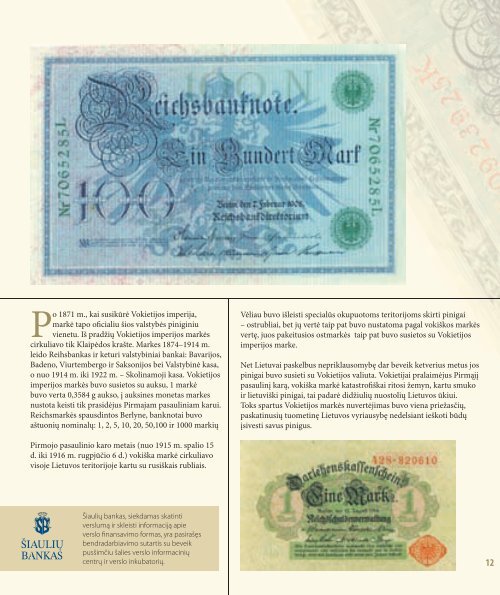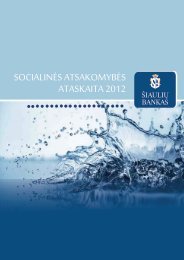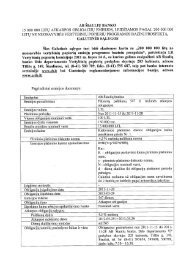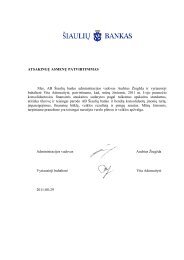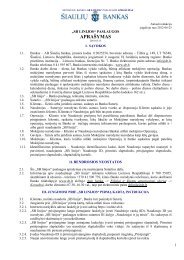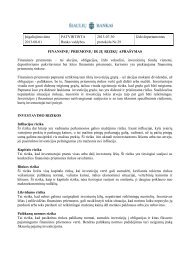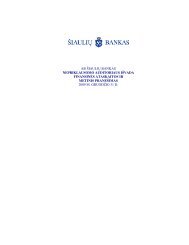Po 1871 m., kai susikūrė Vokietijos imperija, markė ... - Šiaulių bankas
Po 1871 m., kai susikūrė Vokietijos imperija, markė ... - Šiaulių bankas
Po 1871 m., kai susikūrė Vokietijos imperija, markė ... - Šiaulių bankas
You also want an ePaper? Increase the reach of your titles
YUMPU automatically turns print PDFs into web optimized ePapers that Google loves.
<strong>Po</strong> <strong>1871</strong> m., <strong>kai</strong> <strong>susikūrė</strong> <strong>Vokietijos</strong> <strong>imperija</strong>,<br />
<strong>markė</strong> tapo o� cialiu šios valstybės piniginiu<br />
vienetu. Iš pradžių <strong>Vokietijos</strong> imperijos <strong>markė</strong>s<br />
cirkuliavo tik Klaipėdos krašte. Markes 1874–1914 m.<br />
leido Reihs<strong>bankas</strong> ir keturi valstybiniai ban<strong>kai</strong>: Bavarijos,<br />
Badeno, Viurtembergo ir Saksonijos bei Valstybinė kasa,<br />
o nuo 1914 m. iki 1922 m. – Skolinamoji kasa. <strong>Vokietijos</strong><br />
imperijos <strong>markė</strong>s buvo susietos su auksu, 1 <strong>markė</strong><br />
buvo verta 0,3584 g aukso, į auksines monetas markes<br />
nustota keisti tik prasidėjus Pirmajam pasauliniam karui.<br />
Reichs<strong>markė</strong>s spausdintos Berlyne, banknotai buvo<br />
aštuonių nominalų: 1, 2, 5, 10, 20, 50,100 ir 1000 markių.<br />
Pirmojo pasaulinio karo metais (nuo 1915 m. spalio 15<br />
d. iki 1916 m. rugpjūčio 6 d.) vokiška <strong>markė</strong> cirkuliavo<br />
visoje Lietuvos teritorijoje kartu su rusiš<strong>kai</strong>s rubliais.<br />
<strong>Šiaulių</strong> <strong>bankas</strong>, siekdamas skatinti<br />
verslumą ir skleisti informaciją apie<br />
verslo fi nansavimo formas, yra pasirašęs<br />
bendradarbiavimo sutartis su beveik<br />
pusšimčiu šalies verslo informacinių<br />
centrų ir verslo inkubatorių.<br />
Vėliau buvo išleisti specialūs okupuotoms teritorijoms skirti pinigai<br />
– ostrubliai, bet jų vertė taip pat buvo nustatoma pagal vokiškos <strong>markė</strong>s<br />
vertę, juos pakeitusios ost<strong>markė</strong>s taip pat buvo susietos su <strong>Vokietijos</strong><br />
imperijos marke.<br />
Net Lietuvai paskelbus nepriklausomybę dar beveik ketverius metus jos<br />
pinigai buvo susieti su <strong>Vokietijos</strong> valiuta. Vokietijai pralaimėjus Pirmąjį<br />
pasaulinį karą, vokiška <strong>markė</strong> katastro� š<strong>kai</strong> ritosi žemyn, kartu smuko<br />
ir lietuviški pinigai, tai padarė didžiulių nuostolių Lietuvos ūkiui.<br />
Toks spartus <strong>Vokietijos</strong> <strong>markė</strong>s nuvertėjimas buvo viena priežasčių,<br />
paskatinusių tuometinę Lietuvos vyriausybę nedelsiant ieškoti būdų<br />
įsivesti savus pinigus.<br />
12<br />
12
13<br />
13<br />
A� er the German Empire came into being in 1870, the mark<br />
became the state’s o� cial currency unit. At � rst, German im<br />
perial ьarks circulated only in Klaipėda (Memel) territory. In<br />
1874-1914, marks were issued by the Reichsbank and four state<br />
banks: those of Bavaria, Baden, Wurttemburg, and Saxony as<br />
well as the state treasury, and from 1914 until 1922 by the Credit<br />
Treasury. German imperial marks were backed by gold. One mark<br />
was worth 0.3584 g of gold. It was only at the outbreak of World<br />
War I that marks stopped being convertible to gold coins.<br />
Reichsmarks were printed in Berlin; there were eight denominations<br />
of banknotes: 1, 2, 5, 10, 20, 50,100 and 1,000 marks.<br />
Reichs<strong>markė</strong>s pasižymėjo<br />
sudėtingu gra� niu piešiniu ir<br />
ornamentu, o jų kaligra� jos<br />
tradicijas perėmė ir vėlesnių<br />
vokiškų pinigų kūrėjai.<br />
Reichsmarks were noted for their<br />
complex graphic designs and tracery;<br />
these calligraphic traditions were<br />
taken over by later designers of<br />
German paper money.<br />
During World War I (from October 15, 1915 to August<br />
6, 1916), the German mark circulated alongside Russian<br />
rubles in the rest of Lithuania.<br />
Later on, a special currency – the ostmark – was issued for<br />
the occupied territories, although its value was set according<br />
to the value of the German mark; when these were replaced<br />
by ostmarks, they were also pegged to the German imperial<br />
mark.<br />
Even a� er Lithuania declared independence, its currency was<br />
linked to Germany’s for almost four years. When Germany<br />
lost World War I, Lithuania’s currency plunged along<br />
with the German mark, leading to major losses for the<br />
Lithuanian economy. � e rapid devaluation of the German<br />
mark was one of the reasons the Lithuanian government of<br />
the time began urgently seeking ways to introduce its own<br />
currency.<br />
Seeking to foster entrepreneurship and spread<br />
information regarding forms of funding<br />
provided to business <strong>Šiaulių</strong> <strong>bankas</strong> has signed<br />
collaboration agreements with almost half a<br />
hundred of various business information centers<br />
and business incubators in the country.
Daiva Kiburienė<br />
– Administracijos vadovo<br />
pavaduotoja, Verslo ir<br />
mažmeninės bankininkystės<br />
tarnybos vadovė<br />
Banknotai – tai kreditiniai piniginiai ženklai,<br />
išleidžiami emisijos bankų ir atstojantys<br />
metalinius pinigus, <strong>kai</strong>p cirkuliacijos ir mokėjimo<br />
priemones. Ne visi popieriniai pinigai yra<br />
banknotai.<br />
Aps<strong>kai</strong>čiavus pagal<br />
tarptautinius aps<strong>kai</strong>tos<br />
standartus, AB <strong>Šiaulių</strong> <strong>bankas</strong><br />
uždirbo 27,248 mln. litų grynojo<br />
pelno, t. y. beveik dvigubai daugiau<br />
negu 2006 metais, <strong>kai</strong> audituotas<br />
grynasis pelnas siekė 13,6 mln. litų.<br />
Bendroje Lietuvos bankų sistemoje<br />
<strong>Šiaulių</strong> <strong>bankas</strong> pagal pelną jau antrus<br />
metus iš eilės buvo septintas.<br />
Banko grynasis pelnas<br />
The bank’s net profi t<br />
��<br />
��<br />
��<br />
��<br />
��<br />
�<br />
�<br />
����<br />
2007 m. gruodžio 31 d. AB <strong>Šiaulių</strong><br />
banko turtas sudarė 2,013 mlrd. litų<br />
– per metus jis išaugo 49 procentais,<br />
arba 665 mln. litų. Pagal valdomo<br />
turto dalį Lietuvos bankų sektoriuje<br />
<strong>Šiaulių</strong> <strong>bankas</strong> užėmė aštuntą<br />
vietą. Viena iš augimą sąlygojusių<br />
priežasčių buvo padidėjęs kreditų<br />
portfelis.<br />
Banko turtas<br />
The bank’s assets<br />
����<br />
����<br />
����<br />
����<br />
���<br />
�<br />
����<br />
����<br />
����<br />
����<br />
����<br />
Praėjus pusmečiui, <strong>kai</strong> <strong>Šiaulių</strong> banko<br />
akcijos buvo pradėtos kotiruoti<br />
Vilniaus vertybinių popierių biržos<br />
(VVPB) ofi cialiajame sąraše, 2007 m.<br />
liepą banko akcijos buvo įtrauktos<br />
į Baltijos šalių vertybinių popierių<br />
rinkos prekybinį indeksą OMX Baltic<br />
10 (OMXB 10). VVPB ofi cialiajame<br />
sąraše listinguojamas <strong>Šiaulių</strong> <strong>bankas</strong><br />
įvertintas <strong>kai</strong>p viena iš dešimties<br />
likvidžiausių Baltijos šalių bendrovių<br />
ir pateko į likvidžiausių lietuviškų<br />
����<br />
����<br />
Calculating in compliance with the<br />
international accounting standards,<br />
<strong>Šiaulių</strong> <strong>bankas</strong> earned LTL 27,248<br />
million in net profi ts, i.e. almost twice<br />
as much as in 2006 when the audited<br />
net profi t reached LTL 13,6 million. In<br />
the general system of Lithuanian banks<br />
<strong>Šiaulių</strong> <strong>bankas</strong> takes the seventh place<br />
in terms of profi t for the second year<br />
already.<br />
����<br />
����<br />
����<br />
����<br />
As of December 31 st 2007 the assets of<br />
<strong>Šiaulių</strong> <strong>bankas</strong> AB comprised LTL 2,013<br />
billion and grew by 49 per cent or by LTL<br />
665 million during the year. According to<br />
the share of the managed assets in the<br />
Lithuanian banking sector <strong>Šiaulių</strong> <strong>bankas</strong><br />
has taken the 8 th place. The increase in<br />
loan portfolio accounts for one of the<br />
factors causing such a growth.<br />
����<br />
����<br />
����<br />
����<br />
After half a year since the shares of <strong>Šiaulių</strong><br />
<strong>bankas</strong> have occurred on the Main List<br />
of Vilnius Stock Exchange (VSE), in July<br />
2007 they were also enrolled into the<br />
trading index OMX Baltic 10 (OMXB 10) of<br />
the securities market of the Baltic States.<br />
<strong>Šiaulių</strong> <strong>bankas</strong>, listed on the Main List of<br />
VSE, has been evaluated as one of ten<br />
most liquid companies in the Baltic States<br />
and included into the quadruplet of the<br />
most liquid Lithuanian shares. Also, the<br />
shares of <strong>Šiaulių</strong> <strong>bankas</strong> have been traded<br />
14
15<br />
Banko turto struktūra 2007 m.<br />
The structure of assets<br />
69 % Paskolos (be<br />
fi nansų institucijų)<br />
loans to customers<br />
akcijų ketvertuką. <strong>Šiaulių</strong> banko akcijos<br />
taip pat buvo visų akcijų OMX Baltic<br />
(OMXB) ir Vilniaus visų akcijų (OMXV)<br />
indeksuose bei bendrame Baltijos šalių<br />
vertybinių popierių rinkos lyginamajame<br />
indekse OMXBB.<br />
Didžiausias <strong>Šiaulių</strong> banko akcininkas<br />
– Europos rekonstrukcijos ir plėtros<br />
<strong>bankas</strong> (ERPB). Jam priklauso 16,06 proc.<br />
visų banko akcijų. Tačiau <strong>Šiaulių</strong> <strong>bankas</strong><br />
ir toliau išlieka vienu iš daugiausiai<br />
lietuviško kapitalo turinčių bankų šalyje<br />
– Lietuvos rezidentams, įmonėms bei<br />
privatiems asmenims priklauso 71 proc.<br />
banko įstatinio kapitalo. ERPB investicijos<br />
suteikė naują postūmį banko veiklai,<br />
padidino banko patikimumą klientų<br />
akyse ir tarptautinėse fi nansų rinkose.<br />
Akcininkų s<strong>kai</strong>čius, vnt.<br />
2005 2121<br />
2006 2539<br />
2007 3495<br />
2007 m. <strong>Šiaulių</strong> <strong>bankas</strong> išplatino dvi<br />
akcijų emisijas, kurių bendra nominalioji<br />
vertė buvo 52 mln. litų. Metų pabaigoje<br />
<strong>Šiaulių</strong> banko įstatinis kapitalas sudarė<br />
161 mln. litų.<br />
9 % Lėšos bankuose ir kitose<br />
fi nansų institucijose<br />
due to the banks and other<br />
fi nancial institutions<br />
9 % Investicijos į vertybinius<br />
popierius<br />
investments into securities<br />
9 % Pinigai ir lėšos Lietuvos<br />
banke<br />
cash and due to the Bank of<br />
Lithuania<br />
2 % Ilgalaikis turtas<br />
tangible fi xed assets<br />
in all share indexes of OMX Baltic (OMXB)<br />
and Vilnius (OMVXV) as well as in the<br />
OMX Baltic Benchmark (OMXBB).<br />
The major shareholder of <strong>Šiaulių</strong> <strong>bankas</strong><br />
is the European Bank for Reconstruction<br />
and Development. It owns 16.06 per<br />
cent of the bank’s shares. However,<br />
<strong>Šiaulių</strong> <strong>bankas</strong> still remains one of the<br />
banks in the country with the biggest<br />
share of Lithuanian capital as 71 per<br />
cent of the bank’s authorized capital<br />
belongs to the Lithuanian residents,<br />
enterprises and private customers. While<br />
investments from the EBRD gave a new<br />
boost to the banking activities, increased<br />
the bank’s reliability among the clients<br />
and in the international fi nancial<br />
markets.<br />
The number of shareholders, in units<br />
2005 2121<br />
2006 2539<br />
2007 3495<br />
In 2007 <strong>Šiaulių</strong> <strong>bankas</strong> disseminated<br />
two share issues, the total par value of<br />
which comprised LTL 52 million. Late in<br />
the year the authorized capital of <strong>Šiaulių</strong><br />
<strong>bankas</strong> was LTL 161 million.<br />
Daiva Kiburienė – Deputy Chief Executive Offi cer, Head of the Corporate<br />
and Retail Banking Division<br />
Banknotes – are promissory notes which are<br />
issued by a bank and which replaced metal money<br />
as a means of payment. Not all paper moneys are<br />
considered to be banknotes.
<strong>Vokietijos</strong> kariuomenė 1915 m. okupavo<br />
Lietuvą ir įjungė ją į Oberosto (Rytų<br />
krašto) sudėtį. 1916 m. balandį išleisti<br />
specialūs Osto pinigai – Rytų skolinamosios<br />
kasos ženklai, kitaip – ostrubliai, ir paskelbti<br />
vienintele teisėta valiuta Lietuvoje.<br />
Ostrublius leido specialiai tam Rytų prekybos<br />
ir pramonės banko įkurta Rytų skolinamoji<br />
kasa <strong>Po</strong>znanėje. Vienas ostrublis prilygo<br />
½ <strong>markė</strong>s, ostrubliai spausdinti Berlyne,<br />
užrašai ant jų buvo vokiečių, lietuvių, lenkų<br />
ir latvių kalbomis. Ostrubliai cirkuliavo<br />
Lietuvoje, Latvijoje, dalyje dabartinės Lenkijos<br />
ir Baltarusijos. Ostrubliai buvo septynių<br />
nominalų (0,2, 0,5, 1, 3, 10, 25, ir 100), jų<br />
ornamentika panaši į rusiškų rublių, išlaikyti ir<br />
tik rubliams būdingi nominalai.<br />
<strong>Šiaulių</strong> <strong>bankas</strong>, pasinaudodamas Europos rekonstrukcijos<br />
ir plėtros banko patirtimi, pirmasis iš visų šalyje veikiančių<br />
bankų parengė savo mikrokreditavimo programą ir<br />
sėkmingai ją vykdo jau septintus metus.<br />
Išlaikyti ir<br />
tik rubliams<br />
būdingi<br />
nominalai.<br />
Lietuvos Tarybai 1918 m. vasario 16 d. paskelbus nepriklausomybę, Lietuvos ir <strong>Vokietijos</strong> susitarimu pinigų emisijos teisė palikta<br />
Rytų skolinamajai kasai, kuri buvo reorganizuota į atskirą kredito įstaigą ir persikėlė į Kauną. Čia 1918 m. balandžio 4 d. buvo išleisti<br />
aštuonių nominalų banknotai: 0,5, 1, 2, 5, 20, 50, 100 ir 1000 markių. 1919 m. vasario 26 d. Lietuvos vyriausybė pakeitė o� cialų pinigų<br />
pavadinimą: ost<strong>markė</strong> pavadinta auksinu, pfenigas – skatiku. <strong>Po</strong> lito įvedimo ostrubliai ir ost<strong>markė</strong>s buvo keičiamos į litus santykiu<br />
175:1, vėliau – vyriausybės kas savaitę ar dažniau nustatomu kursu.<br />
Nei ostrubliai, nei ost<strong>markė</strong>s nebuvo padengtos realiomis vertybėmis, todėl Lietuvai atnešė nemenkų nuostolių.<br />
Ostrubles were<br />
issued in the same<br />
denominations as<br />
rubles.<br />
16
17<br />
The German army occupied Lithuania in<br />
1915 and incorporated it into the Ober Ost.<br />
In April 1916, a special Ost (East) currency<br />
was issued – Eastern Credit Bank notes, also known<br />
as ostrubles – which were declared the only legal<br />
tender in Lithuania.<br />
� e Eastern Trade and Industry Bank created an<br />
Eastern Credit Bank in <strong>Po</strong>znan expressly for issuing<br />
the notes. One ostruble was equivalent to ½ mark.<br />
Ostrubles were printed in Berlin, with markings in<br />
German, Lithuanian, Latvian and <strong>Po</strong>lish. Ostrubles<br />
circulated in Lithuania, Latvia, and parts of presentday<br />
<strong>Po</strong>land and Belarus. Ostrubles were issued in<br />
seven denominations – 0,2, 0,5, 1, 3, 10, 25, and 100.<br />
� eir design was similar to Russian rubles, and they<br />
were issued in the same denominations as rubles.<br />
Ostmarkių averse<br />
garantuojama,<br />
kad ateityje Rytų<br />
skolinamosios kasos<br />
ženklai bus iškeisti į<br />
reichsmarkes.<br />
� e ostmark’s obverse<br />
side bore treasury<br />
inscriptions guaranteeing<br />
that in future the Eastern<br />
Credit Bank’s money would<br />
be convertible to reichsmarks.<br />
A� er the Supreme Council of Lithuania<br />
declared independence on February<br />
16, 1918, according to a deal between<br />
Lithuania and Germany, the right<br />
to issue money remained with the<br />
Eastern Credit Bank, which was<br />
reorganised into a separate credit<br />
agency and moved to Kaunas. On<br />
April 4, 1918 banknotes in eight<br />
denominations were issued: 0,5, 1, 2,<br />
5, 20, 50, 100 and 1,000 marks. On<br />
February 26, 1919 the Lithuanian<br />
government changed the currency’s<br />
o� cial name: the ostmark became<br />
the auksinas; the pfennig became<br />
the skatikas. A� er the auksinas<br />
became known as the litas, ostrubles<br />
and ostmarks were exchangeable at a<br />
rate of 175:1; and later on, according to<br />
an exchange rate set by the government<br />
each week, or even more frequently.<br />
Neither the ostruble nor the<br />
ostmark were backed by anything<br />
of real value, which caused huge<br />
losses for Lithuania.<br />
Taking the advantage of the experience of the European Bank for<br />
Reconstruction and Development, <strong>Šiaulių</strong> <strong>bankas</strong> was the fi rst bank among<br />
all the banks operating in the country to prepare its own micro-lending<br />
programme, which has been successfully implemented for the seventh<br />
year already.
Jonas Bartkus – Administracijos vadovo<br />
pavaduotojas, Verslo plėtros tarnybos vadovas<br />
Bonai – tai trumpalaikiai valstybės iždo,<br />
municipalitetų, taupomųjų bankų, pašto įstaigų ar<br />
kompanijų skoliniai įsipareigojimai, naudojami <strong>kai</strong>p<br />
pirkimo ir mokėjimo priemonės, arba išėję iš apyvartos<br />
popieriniai pinigai, tapę kolekcionavimo objektu.<br />
Nors 2007 metais buvo sugriežtintos paskolų<br />
teikimo sąlygos, be to, paskolų palūkanų<br />
norma nuolat kilo, <strong>Šiaulių</strong> <strong>bankas</strong> padidino<br />
savąją paskolų dalį bendroje šalies rinkoje<br />
– klientams išduotų kreditų portfelis pernai<br />
padidėjo daugiau nei 55 procentais ir metų<br />
pabaigoje išaugo beveik iki 1,541 mlrd. litų.<br />
Banko suteiktos paskolos nefi nansinėms<br />
institucijoms per 2007 metus išaugo 56<br />
proc. Šiame paskolų portfelyje dominuoja<br />
paskolos smulkaus ir vidutinio verslo<br />
įmonėms - 74 proc., per 2007 metus šių<br />
paskolų portfelis padidėjo 48 proc. Paskolos<br />
gyventojams per 2007 metus išaugo 91<br />
proc. ir sudarė 20 proc. paskolų portfelio<br />
nefi nansinėms institucijoms.<br />
Paskolų struktūra<br />
The structure of loans<br />
74 % Smulkios ir<br />
vidutinės įmonės<br />
Small and mediumsized<br />
enterprises<br />
2007 m. didėjo ir klientų indėliai, laikomi<br />
banke. Pernai indėlių suma pirmą kartą<br />
peržengė milijardo ribą ir buvo 1,217<br />
mlrd. litų – nuo 2006 m. gruodžio 31 d. iki<br />
praėjusių metų paskutinės dienos indėlių<br />
suma padidėjo 30 procentų. Gyventojų<br />
indėlių portfelis išaugo 39 procentais – iki<br />
797 mln. litų. Tarp gyventojų populiariausi<br />
išliko terminuotieji indėliai. <strong>Šiaulių</strong> <strong>bankas</strong><br />
2007 m. užėmė 3,3 procentus visos indėlių<br />
rinkos Lietuvoje.<br />
Pritraukti resursai, tūkst. Lt<br />
The types of deposits, in LTL thou<br />
Though loan granting conditions were<br />
stiff ened in 2007 and loan interest rates<br />
were constantly growing, <strong>Šiaulių</strong> <strong>bankas</strong><br />
increased its loan share in the country’s total<br />
loan market – the customer loan portfolio<br />
increased by 55 per cent last year and late in<br />
the year grew up to almost LTL 1,541 billion.<br />
During 2007 the bank’s loans granted to<br />
non-fi nancial institutions grew by 56 per cent.<br />
Loans to small and medium-sized business<br />
were prevailing in this loan portfolio, they<br />
comprised 74 per cent, and during 2007 this<br />
loan portfolio increased by 48 per cent. Loans<br />
to residents grew by 91 per cent in the course<br />
of 2007 and comprised 20 per cent of the<br />
loan portfolio to non-fi nancial institutions.<br />
20 % Privatūs<br />
asmenys<br />
Private entities<br />
6 % Kiti<br />
Other<br />
The clients’ deposits with the bank have also<br />
grown during 2007. Last year for the fi rst time<br />
the deposit amount exceeded one billion<br />
and reached LTL 1,217 billion – calculating<br />
from December 31st The clients’ deposits with the bank have also<br />
grown during 2007. Last year for the fi rst time<br />
the deposit amount exceeded one billion<br />
and reached LTL 1,217 billion – calculating<br />
from December 31 2006 to the last day<br />
of the previous year the deposit amount<br />
increased by 30 percent. The residents’<br />
deposit portfolio has grown by 39 per cent<br />
up to LTL 797 million. In 2007 the bank had<br />
3.3 per cent of the total deposit market in<br />
Lithuania.<br />
st 2006 to the last day<br />
of the previous year the deposit amount<br />
increased by 30 percent. The residents’<br />
deposit portfolio has grown by 39 per cent<br />
up to LTL 797 million. In 2007 the bank had<br />
3.3 per cent of the total deposit market in<br />
Lithuania.<br />
910 059 Klientų terminuotieji indėliai Time deposits<br />
306 883 Klientų lėšos banko sąs<strong>kai</strong>tose Demand deposits<br />
454 671<br />
Lėšos iš bankų bei fi nansų ir<br />
kredito institucijų<br />
Due to other banks and fi nancial<br />
institutions<br />
36 092 Specialieji ir skolinimosi fondai Special and lending funds<br />
Pajamų struktūra<br />
The structure of income<br />
59 % Grynosios<br />
palūkanų pajamos<br />
Net interest income<br />
17 % Pelnas iš operacijų<br />
vertybiniais popieriais ir<br />
užsienio valiuta<br />
Profi t from operations in<br />
securities and foreign currency<br />
1 % Kitos pajamos<br />
Other income<br />
10 % Pajamos už nuosavybės<br />
vertybinius popierius<br />
Income from equity securities<br />
13 % Grynosios paslaugų ir<br />
komisinių pajamos<br />
Net fee and commission<br />
income<br />
18
19<br />
Išlaidų struktūra<br />
The structure of expense<br />
46 % Darbo užmokestis ir<br />
kitos susijusios išlaidos<br />
Salaries and other related<br />
expense<br />
17 % Kitos operacinės<br />
išlaidos<br />
Other operating expense<br />
Grynosios palūkanų pajamos, palyginti su<br />
ankstesniais metais, išaugo 40 procentų<br />
– iki 42,6 mln. litų. Pajamoms augant<br />
sparčiau negu išlaidoms, pagerėjo ir<br />
<strong>Šiaulių</strong> banko išlaidų bei pajamų santykis<br />
– per atas<strong>kai</strong>tinį laikotarpį jis sumažėjo iki<br />
47,11 procento.<br />
2007 metais <strong>bankas</strong> vykdė visus<br />
Lietuvos banko nustatytus veiklos riziką<br />
ribojančius normatyvus. Banko likvidumo<br />
rodiklis sudarė 44,03 procento, kapitalo<br />
pakankamumo rodiklis siekė 15,30<br />
procento.<br />
Pagrindiniai AB <strong>Šiaulių</strong> banko balansiniai straipsniai, tūkst. Lt<br />
The main balance-sheet entries of <strong>Šiaulių</strong> <strong>bankas</strong> AB, in LTL thou<br />
Turtas<br />
Assets<br />
Paskolos klientams (gryn.v.)<br />
Loans to customers (fair value)<br />
Indėliai<br />
Deposits<br />
Akcininkų nuosavybė<br />
Shareholders’ equity<br />
5 % Kitos išlaidos<br />
Other expense<br />
8 % Amortizacija ir<br />
nusidėvėjimas<br />
Amortization and depreciation<br />
12 % Išlaidos specialiesiems<br />
atidėjiniams<br />
Expense for special provisions<br />
12 % Indėlių draudimo išlaidos<br />
Compulsory insurane of deposits<br />
In comparison with the last year net<br />
interest income grew by 40 per cent<br />
up to LTL 42,6 million. <strong>Šiaulių</strong> <strong>bankas</strong><br />
income/cost ratio improved due to the<br />
faster grow of income in comparison with<br />
expenses – during the accounting period<br />
it has decreased up to 47.11 per cent.<br />
In 2007 <strong>Šiaulių</strong> <strong>bankas</strong> implemented all<br />
the standards limiting the activity risk<br />
established by the Bank of Lithuania. The<br />
bank’s liquidity ratio comprises 44.03 per<br />
cent while the capital adequacy ratio<br />
reached 15,30 percent.<br />
2005-12-31 2006-12-31 2007-12-31<br />
1 039 010 1 348 033 2 013 146<br />
659 081 990 939 1 540 637<br />
743 848 935 749 1 216 942<br />
90 233 152 190 269 617<br />
Pagrindiniai AB <strong>Šiaulių</strong> banko pelningumo rodikliai, tūkst. Lt<br />
The main profi tability ratios of <strong>Šiaulių</strong> <strong>bankas</strong> AB, in LTL thou<br />
Grynasis pelnas, tūkst. Lt.<br />
Net profi t, in LTL thou<br />
Grynoji palūkanų marža, %<br />
Net interest margin, %<br />
Išlaidų ir pajamų santykis, %<br />
Cost to income, %<br />
Vidutinis turto pelningumas (ROAA), %<br />
Average return on assets (ROAA), %<br />
Vidutinis kapitalo pelningumas (ROAE), %<br />
Average return on equity (ROAE), %<br />
2005-12-31 2006-12-31 2007-12-31<br />
8 103 13 651 27 248<br />
2,62 2,50 2,54<br />
72,56 63,56 47,11<br />
0,93 1,12 1,62<br />
10,47 11,80 12,92<br />
Jonas Bartkus – Deputy Chief Executive Offi cer,<br />
Head of the Business Development Division<br />
Bearer bonds – are short-term obligations issued<br />
by state treasuries, municipalities, savings<br />
banks, post o� ces, or � rms which are used as<br />
means of payment or that have been removed from<br />
circulation and become collectible objects.
Pirmojo pasaulinio karo<br />
metais ir tuoj po jo, be<br />
įvairių Rusijoje ir Vokietijoje<br />
leistų popierinių pinigų, Lietuvoje<br />
cirkuliavo dar ir vietinių valdžios<br />
organų, bankų ir net karinių junginių<br />
išleisti pinigai. Tai buvo dažniausiai<br />
mažo nominalo, nedidelio formato<br />
ant prasto popieriaus atspausti<br />
pinigai, galioję tik trumpą laiką ir<br />
ribotoje teritorijoje.<br />
1917–1922 m. Klaipėdoje, Rusnėje ir Šilutėje vietinė administracija<br />
išleido į apyvartą savus pinigus. Banknotai buvo spausdinami<br />
Klaipėdoje ir Vokietijoje ir nuo kitų vietinių pinigų skyrėsi šiek tiek<br />
geresne poligra� ne kokybe.<br />
<strong>Šiaulių</strong> <strong>bankas</strong> – universalus<br />
<strong>bankas</strong>, teikiantis paslaugas ir<br />
privatiems, ir verslo klientams.<br />
Pritrūkus metalinių pinigų, 1915 m. savo<br />
pinigus išleido Sedos komendantūra. Pinigai<br />
spausdinti Klaipėdoje iškiliąja spauda, jie buvo<br />
vienpusiai, aštuonių nominalų (nuo 1 iki 50<br />
kapeikų), nedidelio formato, antspauduoti<br />
skirtingais antspaudais ir galiojo tik metus.<br />
Pinigus leido ir Vakarų savanorių armija, kitaip<br />
– bermontinin<strong>kai</strong>. Nors pats P. Bermontas<br />
skelbė, kad jo tikslas išvaduoti Petrogradą<br />
nuo bolševikų, jo daliniai pasižymėjo<br />
tik plėšikavimu. Norėdami įteisinti savo<br />
plėšikavimą, su Šiaurės Lietuvos gyventojais<br />
jie atsis<strong>kai</strong>tydavo pačių išleistomis bevertėmis<br />
<strong>markė</strong>mis, jų 1919 m. išleistų kupiūrų<br />
nominalai buvo 1, 5, 10 ir 50.<br />
Savus pinigus 1920 m. išleido ir keturi<br />
Vilniaus ban<strong>kai</strong>. Vilniaus bankų <strong>markė</strong>s buvo<br />
keturių nominalų (1, 5, 10 ir 20), išleistos ant<br />
spalvoto popieriaus ir numeruotos rankiniu<br />
numeratoriumi.<br />
Nors Panevėžyje Sovietų valdžia gyvavo tik<br />
nuo 1918 m. gruodžio iki 1919 m. gegužės,<br />
ji spėjo išleisti savo Panevėžio darbininkų<br />
atstovų tarybos penkių nominalų (25 ir 50<br />
kapeikų bei 1, 3 ir 5 rublių) pinigus. Jie buvo<br />
nevienodo dydžio, spausdinti Panevėžyje ant<br />
laikraštinio popieriaus, naudojant skirtingus<br />
šri� us.<br />
20
21<br />
During World War I and its immediate<br />
a� ermath, in addition to the various<br />
types of paper money issued in<br />
Russia and Germany, money also circulated in<br />
Lithuania that was issued by local governments,<br />
banks, and even military units. � ese were most<br />
o� en small format and small-denomination<br />
moneys printed on poor-quality paper, valid<br />
only within a limited geographic area and only<br />
for a short period of time.<br />
Due to a shortage of metal coins, the German<br />
military government in Sėda region issued its<br />
own currency in 1915 . � e money was printed<br />
in Klaipėda using an o� set press; it was singlesided<br />
and came in eight denominations (from<br />
1 to 50 kopeks). It was small in format, stamped<br />
di� erently, and valid for one year only.<br />
Money was issued even by the “Western Volunteer Army”, also known as the “Bermondtians”. Although, Pavel Bermondt proclaimed<br />
that his aim was the liberation of Saint Petersburg from the Bolsheviks, his units were known mostly for their looting. � ey issued<br />
their own worthless marks which were used in trade with the inhabitants of northern Lithuania; their 1919 coupons were issued in<br />
denominations of 1, 5, 10 and 50.<br />
Ant Šilutės seniūnijos<br />
tarybos išleistos 1 <strong>markė</strong>s<br />
– nuo Šilutės kilusio<br />
žymaus vokiečių rašytojo<br />
Hermano Zudermano<br />
(1857–1928) nuotrauka.<br />
� e 1-mark note issued by<br />
the Šilutė elderate bore a<br />
photograph of the famous<br />
German writer Herman<br />
Sudermann (1857-1928)<br />
who was born in the town.<br />
In 1920, four Vilnius banks issued private<br />
currencies: marks, in four denominations – 1,<br />
5, 10 and 20 – which were printed on coloured<br />
paper and numbered using a hand-operated<br />
numbering stamp.<br />
Even though the Soviet government<br />
in Panevėžys existed only from December, 1918 to<br />
May, 1919, it managed to issue its own workers’<br />
council money in � ve denominations – 25 and 50<br />
kopeks, and 1, 3 and 5 rubles. � e bills’ size was<br />
not uniform, and they were printed on newsprint<br />
in Panevėžys, in di� ering fonts.<br />
In 1917-1922, local administration in Klaipėda,<br />
Rusnė and Šilutė introduced their own money<br />
into circulation. � e banknotes were printed in<br />
Klaipėda and Germany and di� ered from other<br />
local currencies by their slightly better quality of<br />
printing.<br />
<strong>Šiaulių</strong> <strong>bankas</strong> is the<br />
multipurpose bank providing<br />
services to both private and<br />
corporate customers.
Pirmieji banknotų pirmta<strong>kai</strong> – valstybiniai skolos rašteliai – išleisti 1024 m.<br />
Kinijoje, valdant Sungų dinastijai. Jie spausdinti varinėmis klišėmis ant iš<br />
šilkmedžio žievės pagaminto popieriaus, kuris buvo atsparus lankstymui ir<br />
glamžymui.<br />
Vita Adomaitytė – vyriausioji<br />
buhalterė, Aps<strong>kai</strong>tos ir ats<strong>kai</strong>tomybės<br />
tarnybos vadovė<br />
2007-ieji <strong>Šiaulių</strong> bankui buvo<br />
įvairūs ir spalvingi. Banko fi nansinį<br />
stabilumą ir pajėgumą palankiai<br />
įvertino nepriklausomi ekspertai<br />
– vasario mėnesį tarptautinė reitingų<br />
agentūra „Moody’s” <strong>Šiaulių</strong> bankui<br />
suteikė aukštesnius reitingus: ilgalaikio<br />
skolinimosi reitingą padidino iki Ba2,<br />
fi nansinio pajėgumo reitingą – iki D.<br />
Trumpalaikio skolinimosi reitingas – NP,<br />
ilgalaikio reitingo perspektyva – stabili.<br />
Pripažinimą tarptautinėje paskolų<br />
rinkoje <strong>Šiaulių</strong> <strong>bankas</strong> pelnė prieš<br />
porą metų, <strong>kai</strong> fi nansiniu jo partneriu<br />
ir didžiausiu akcininku tapo Europos<br />
rekonstrukcijos ir plėtros <strong>bankas</strong> (ERPB).<br />
Pastaruosius keletą metų <strong>bankas</strong><br />
sėkmingai mezgė ryšius su užsienio<br />
partneriais tarptautinėse fi nansų<br />
rinkose.<br />
2007 m. kovo mėnesį <strong>bankas</strong> pasirašė<br />
sutartį su Europos Tarybos Vystymo<br />
banku (ETVB) dėl 10 mln. eurų<br />
kreditinės linijos suteikimo smulkiajam<br />
ir vidutiniam verslui fi nansuoti. Tai buvo<br />
jau trečioji Europos Tarybos Vystymosi<br />
banko ir <strong>Šiaulių</strong> banko paskolos sutartis.<br />
2007 m. vasarą <strong>bankas</strong> pasirašė 30<br />
mln. eurų pirmąją sindikuotą paskolą,<br />
kuri buvo pati didžiausia <strong>Šiaulių</strong> banko<br />
kreditinė linija iš tarptautinių fi nansinių<br />
organizacijų. Bendrai banko veiklai<br />
fi nansuoti skirtą paskolą <strong>Šiaulių</strong> bankui<br />
organizavo Austrijos <strong>bankas</strong> Raiff eisen<br />
Zentralbank Osterreich AG ir <strong>Vokietijos</strong><br />
<strong>bankas</strong> HSH Nordbank AG. Kartu su<br />
šiais dviem ban<strong>kai</strong>s paskolos lėšas<br />
suteikė ban<strong>kai</strong> iš <strong>Vokietijos</strong>, Austrijos,<br />
Šveicarijos, <strong>Po</strong>rtugalijos, Norvegijos,<br />
Prancūzijos ir Lenkijos – iš viso trylika<br />
Europos šalių bankų. 2007 m. pradėta<br />
įsisavinti <strong>Vokietijos</strong> fi nansų ir kredito<br />
kompanijos „KfW Bankengruppe”<br />
10 mln. eurų kreditinė linija, gauta<br />
dešimčiai metų. Lėšos buvo naudojamos<br />
regioniniams projektams fi nansuoti,<br />
plečiant banko bendradarbiavimą su<br />
miestų bei rajonų savivaldybėmis.<br />
22
23<br />
The year of 2007 was sundry and<br />
colorful. The fi nancial stability and<br />
strength of <strong>Šiaulių</strong> <strong>bankas</strong> AB were<br />
favourably assessed by the independent<br />
experts - in February 2007 the<br />
international rating agency “Moody’s”<br />
provided the following higher ratings<br />
to <strong>Šiaulių</strong> <strong>bankas</strong>: a long-term deposit<br />
rating up to Ba2 and fi nancial strength<br />
rating up to D. While a short-term<br />
deposit rating was NP and a long-term<br />
rating outlook remained stable.<br />
A couple of years ago <strong>Šiaulių</strong> <strong>bankas</strong><br />
won recognition in the international<br />
loan market when the European Bank<br />
for Reconstruction and Development<br />
(EBRD) became its major shareholder.<br />
During the several recent years the bank<br />
has been successfully affi liating with<br />
the foreign partners in the international<br />
fi nancial markets.<br />
In March 2007 the bank signed an<br />
agreement with the Council of Europe<br />
Development Bank (CEB) regarding<br />
granting the credit line of EUR 10 million<br />
to fi nance small and medium-sized<br />
Finansavimo šaltinių struktūra<br />
The structure of the fi nancial sources<br />
48 % Gyventojai<br />
Residents<br />
business. This was already the third<br />
loan agreement entered between<br />
the Council of Europe Development<br />
Bank and <strong>Šiaulių</strong> <strong>bankas</strong>. In summer<br />
of 2007 the bank signed the fi rst<br />
syndicated loan of EUR 30 million,<br />
which was the biggest credit line<br />
granted to <strong>Šiaulių</strong> <strong>bankas</strong> from the<br />
international fi nancial organizations.<br />
The loan assigned for corporate<br />
banking purposes was arranged to<br />
<strong>Šiaulių</strong> <strong>bankas</strong> by the Austrian bank<br />
Raiff eisen Zentralbank Osterreich AG<br />
and German bank HSH Nordbank<br />
AG. Together with these two banks<br />
the loan funds were granted by<br />
the banks from Germany, Austria,<br />
Switzerland, <strong>Po</strong>rtugal, Norway, France<br />
and <strong>Po</strong>land – all in all by thirteen<br />
European banks. In 2007 <strong>Šiaulių</strong><br />
<strong>bankas</strong> started exploiting a ten-year<br />
credit line of EUR 10 million granted<br />
by the German credit and fi nance<br />
institution “KfW Bankengruppe”. The<br />
funds were used to provide funding<br />
to regional projects developing the<br />
collaboration with town and regional<br />
municipalities.<br />
25 % Verslo klientai<br />
Corporate clients<br />
27 % Ban<strong>kai</strong> ir<br />
kitos fi nansinės<br />
institucijos<br />
Banks and other<br />
fi nancial institutions<br />
Vita Adomaitytė – Chief Financial Offi cer, Head of the Accounting<br />
and Reporting Division<br />
� e forerunners of banknotes – state treasury notes<br />
– were issued in 1024 in China, under the Sung<br />
Dynasty. � ey consisted of printed paper resilient<br />
to folds and tears made from the bark of mulberry<br />
trees, and using copper striking stamps.


